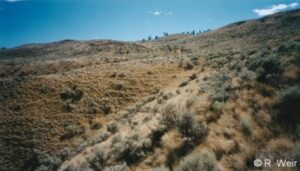Although much of the landscape of the Thompson and Okanagan valleys likely supported viable populations of badgers in the past, several human activities have probably negatively affected badger populations. First, badgers utilize grassland habitats, which are one of the most rare and threatened landscapes in the province. Loss of grassland habitats may be the major contributing factor to the current conservation concern facing badgers (Rahme et al. 1995). Urban encroachment into grasslands, fire suppression, and increased intensity of agriculture in grasslands may have also shifted the ecology of these habitats away from the setting in which badgers have evolved and probably need to survive. Second, badgers and their prey have long been considered pest species by farmers and ranchers and were systematically exterminated by hunting, trapping, and poisoning since European settlers first occupied grasslands. Third, collisions with vehicles on roadways may be a substantial source of mortality within badger populations.
 Effective conservation efforts had been difficult to develop because very limited information was available about the ecology of this species in British Columbia, even though a conservation need had been clearly identified (Rahme et al. 1995). A study on badger ecology conducted in the East Kootenay region (Newhouse and Kinley 2000b), in a limited grassland setting, produced concerning results that suggested that more information specific to British Columbia was needed to develop appropriate management recommendations. The goal of our program was to effectively deal with each of these issues and provide practical solutions to ensure the persistence of badger populations in the Thompson and Okanagan regions of British Columbia.
Effective conservation efforts had been difficult to develop because very limited information was available about the ecology of this species in British Columbia, even though a conservation need had been clearly identified (Rahme et al. 1995). A study on badger ecology conducted in the East Kootenay region (Newhouse and Kinley 2000b), in a limited grassland setting, produced concerning results that suggested that more information specific to British Columbia was needed to develop appropriate management recommendations. The goal of our program was to effectively deal with each of these issues and provide practical solutions to ensure the persistence of badger populations in the Thompson and Okanagan regions of British Columbia.
The specific objectives of our program were the following:
For more information about badgers in the Thompson and Okanagan regions, send an email to info@badgers.bc.ca